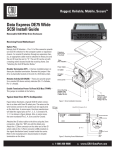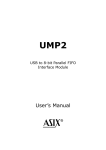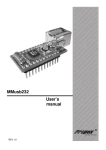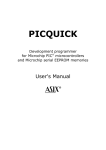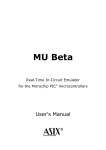Download UMS2 User`s Manual
Transcript
UMS2 USB to UART interface module User’s manual CONTENTS 1. UMS2 3 2. USAGE 3 3. FEATURES 4 4. TECHNICAL REFERENCE 4.1. SCHEMATICS 4.2. TOP VIEW 4.3. BOTTOM VIEW 4.4. PIN DESCRIPTION 5 5 6 6 7 5. DRIVER INSTALLATION 8 6. TECHNICAL SPECIFICATION 6.1. ABSOLUTE RATINGS 6.2. TYPICAL RATINGS 8 8 8 7. CONTACT 9 1. UMS2 UMS2 is a module based on FT8U232BM integrated circuit manufactured by FTDI Ltd., which provides with easy to use USB connectivity to PC without any need of additional knowledge about USB itself. 2. USAGE UMS2 is a USB to UART interface with full hardware flow control capability. It is capable of data transfer rates up to 1 MBd (RS232) and up to 3 MBd (RS485). In addition, there is an EEPROM memory which may be used to store VID and PID identifiers for OEM applications. The module connects by 2 signals directly to USB connector, the application side provides with UART signals including hardware flow control. From mechanical standpoint, the module is arranged as DIP28 with standard pin spacing of 0.1 inch (2.54 mm) so it is possible to fit it into either standard or precise DIP28 socket, or to solder it directly to printed circuit board. The USB connector is to be connected externally which allows the designer to choose the placement of the connector and its type: 'B' or 'mini B' or USB cable soldered directly to the board may be used. This design sigificantly simplifies the development in small production series. There is a separate power supply for IO pins (VCCIO), which allows the module to be connected to 3.0 V application easily. PWREN# signal is designated to drive a P-channel MOSFET for applications which consume more than 100 mA (max. 500 mA) from USB. In such case it is advisable to turn on 'enable pull-down' option in EEPROM configuration. Module UMS2 can also operate in "BitBang mode", in which the data pins act as 8-bit parallel input/output. This mode can be used for example to configure field-programmable logic array directly from PC over USB. Further, there is RSTOUT# signal, which stays in high impedance state for about 2 ms after power up and then it is connected to internal 3.3 V voltage regulator. Signal RSTOUT# is also in high inpedance state whenever signal RESET# is active (RESET#=log.0), but it is not affected by reset from USB (USB Bus RESET). The module is equipped with 93LC56 memory of 128×16 bits. Lower half of this memory is used for module's needs (64×16 bits). Using EEDATA, EESK and EECS the application may use upper 64×16 bits for its own purposes. While the application is accessing module's EEPROM memory, the RESET# signal must be active (RESET#=log.0). Software drivers fow Windows 98/ME/2K/XP, Mac OS8/OS9/OS X and Linux are available for free on FTDI website (http://www.ftdichip.com). 3. FEATURES • • • • • • • • • • • • • • • • Data inputs/outputs 3.0 to 5 V - CMOS compatible Powered from USB or external supply Data transfer rates up to 1 MBd (RS232) and up to 3 MBd (RS485) Full hardware data flow control available 384 byte receive buffer 128 byte transmit buffer Support for RS485 level converter Integrated frequency multiplier 6 MHz - 48 MHz Supports USB 1.1 protocol, USB 2.0 compatible Support for OEM applications (VID and PID can be stored in EEPROM memory, which is part of the module) BitBang mode PWREN# signal for driving P-channel MOSFET for applications consuming more than 100 mA from USB (max. 500 mA) Data flow optimization see web page, application note 4 Ability to use use free EEPROM capacity (64×16 bits) Drivers for Windows 98/2K/ME/XP, Mac OS8/OS9/OS X and Linux available for free DIP28 socket compatible, PCB mountable 4. TECHNICAL REFERENCE 4.1. SCHEMATICS 4.2. TOP VIEW 4.3. BOTTOM VIEW 4.4. PIN DESCRIPTION Pin 1 2 3 4 5 6 7 8 9 10 11 12 13 Label GND VCC RL# RI# DCD# DSR# DTR# CTS# RTS# RXD TXD GND RSO# FTDI GND VCC RXLED# RI# DCD# DSR# DTR# CTS# RTS# RXD TXD GND RSTOUT# Typ PWR PWR O.C. IN IN IN OUT IN OUT IN OUT PWR OUT 14 RST# RESET# IN 15 16 VCC VIO VCC VCCIO PWR PWR 17 18 GND ECS GND EECS PWR I/O 19 ESK EESK OUT 20 EDT EEDATA I/O 21 22 SLP# 3V3 SLEEP# 3V3OUT OUT OUT 23 24 TL# PWRCT TXLED# PWRCTL O.C. IN 25 PWRE# PWREN# OUT Description Signal ground Power supply +4.4 V to 5.25 V Receive LED Ring indicator Data carrier detect Data set ready Data terminal ready Clear to send Request to send Received data Transmitted data Signal ground High impedance for about 2 ms after power up and during #RESET is active, otherwise connected to output of internal 3.3 V voltage regulator. This signal is not affected by USB Bus Reset. External reset. May be left unconnected if not used. Power supply +4.4 V to 5.25 V. Power supply +3.0 V to +5.25 V for output drivers of pins 10..12, 14..16, 18..25. Signal ground EEPROM enable – internal pull-up of 200 kOhm during reset. EEPROM clock - high impedance during reset. EEPROM data I/O - high impedance during reset. Sleep mode indicatotor (log.0) 3.3 V output from internal voltage regulator - this pin can source up to 5 mA. Transmit LED Power supply selection - bus powered (log.0) or external supply (log.1) PWREN# - switched to log.0 after the module is configured and held in log.1 during reset and sleep mode (USB suspend). This signal may be used to drive P-channel MOSFET, which allows to connect applications consuming more than 100 mA from USB. 26 27 TXDE USBDP TXDEN USBDP 28 USBDM USBDM OUT Transmit enable for RS485 I/O USB data signal plus. It is necessary to connect resistor of 1.5 kOhm between USBDP and 3V3OUT or RSTOUT#. I/O USB data signal minus. 5. DRIVER INSTALLATION For Windows operating systems there are two types of drivers: • • Virtual COM port, which can be accessed as common COM port using Win32 API Direct driver, to gain full control of the chip, a DLL to interface the driver is provided Detailed description of driver installation procedure can be found on FTDI website (http://www.ftdichip.com). 6. TECHNICAL SPECIFICATION 6.1. ABSOLUTE RATINGS Storage temperature TSTR min. -65 °C max. 150 °C Operational temperature TPWR min. 0 °C max. 70 °C Power supply voltage VCCMAX min. -0.5 V max. 6.00 V Input voltage – inputs VIN1 min -0.5 V max VCC+0.5 V Input voltage - I/O VIN2 min -0.5 V max VCC+0.5 V Output current – outputs IO1 max 24 mA Output current - I/O IO2 max 24 mA Power WPWR max 500 mW 6.2. TYPICAL RATINGS VCC Operating supply voltage Operating supply current Suspended supply current Input voltage log.1 Input voltage log.0 Output voltage log.1 VCC ICC1 ICC2 VIH VIL VOH Output voltage log.0 VOL Output current log.1 IOH Input current log.0 IOL min. 4.4 V max. 5.25 V max. 50 mA max. 250 µA min. 2.0 V max. 1.0 V min. 2.8 V, Ri=15 kOhm max. 0.3 V, Ri=1.5 kOhm 4 mA, VOH=VCC-0.5 V 8 mA, VOL=0.5 V 7. CONTACT Address: Tel.: Fax: E-Mail: WWW: ASIX s.r.o., Staropramenna 4, 150 00 Prague, Czech Republic +420-257 312 378 +420-257 329 116 [email protected], [email protected], [email protected] www.pic-tools.com Copyright © 1991-2003 ASIX s.r.o. MANUMS2 All trademarks used in this document are properties of their respective owners. This information is provided in the hope that it will be useful, but without any warranty. We disclaim any liability for the accuracy of this information. We are not responsible for the contents of web pages referenced by this document.









